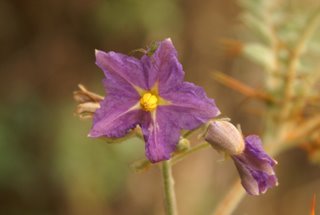 I was browsing some blogs I like and noticed this photo of solanum centrale. I guess it's commonly known as bush tomato, or desert raisin, and though I have never heard of it before, it looks familiar there blooming in the Australian outback, 8000 some-odd miles and two seasons away from here. The flower looks very much like one of my pet weird plants, firethorn or porcupine tomato, which is native to Madagascar but was discovered by me back in Y2K at a plant sale right here in OC. At the time it was barely a 2" pot's worth, but it soon grew to fill out a larger container and even made a trip to the county fair where a plant pavilion worker nicknamed it "Hannibal". Since then it has been transplanted around the garden twice, and is currently growing under the fremontodendron tree. I am posting it here so it can bloom in sweet digital concert at opposite ends of summer with its cousin halfway round the world.
I was browsing some blogs I like and noticed this photo of solanum centrale. I guess it's commonly known as bush tomato, or desert raisin, and though I have never heard of it before, it looks familiar there blooming in the Australian outback, 8000 some-odd miles and two seasons away from here. The flower looks very much like one of my pet weird plants, firethorn or porcupine tomato, which is native to Madagascar but was discovered by me back in Y2K at a plant sale right here in OC. At the time it was barely a 2" pot's worth, but it soon grew to fill out a larger container and even made a trip to the county fair where a plant pavilion worker nicknamed it "Hannibal". Since then it has been transplanted around the garden twice, and is currently growing under the fremontodendron tree. I am posting it here so it can bloom in sweet digital concert at opposite ends of summer with its cousin halfway round the world. So here is my little homage to Solanum pyracanthum, the tomato tough enough to bloom before St. Paddie's Day. While lots of people are thinking green on that day, gardeners are thinking tomato since March 17 is considered The Day to have your garden tomatoes in the ground by, at least in my part of the northern hemisphere. Of course there would be little point in getting your lycopersicum esculentum to bloom so early since the nights are still awfully cold for fruit to set; unless you just really like tomato flowers:
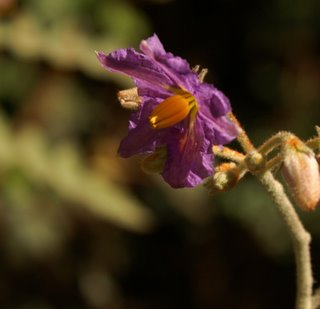
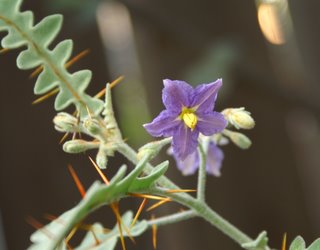
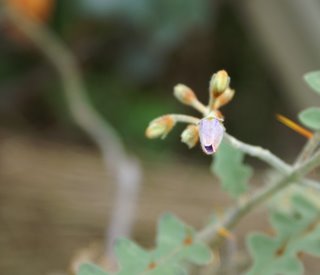
The fruit of s. pyracanthum is small, thorny, inedible. If you let 'em, they'll hang on the branch all winter long and dry up like this.

The overall impression from the plant is reminiscent of a tomato: the sprouts from the leaf axils, the way the stems get bumpy as they mature, the shape of the flower clusters, even the shape of the leaves. Like a tomato plant, but much thornier.
And what about the bugs, you ask? There were lots of green lynx spiderlings on this plant. Last October it was home to a nest of them, and I suppose a certain percentage of the brood doesn't wander too far from home.

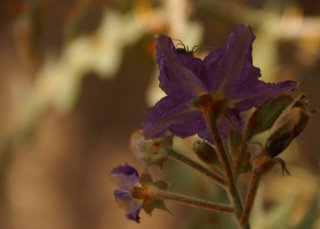

Lacewings attach their eggs to the tips of the spines, effortlessly extending the protective length of the egg stalks. Here is one of them.

There was one solitary ant foraging up and down the leaves. These ants often tend honeydew
 producing sap suckers, like treehoppers and aphids. There weren't any of these around, and I've never noticed them on this plant. Plants in the tomato family host a species of treehopper; maybe this ant was just hopeful, or ambitious.
producing sap suckers, like treehoppers and aphids. There weren't any of these around, and I've never noticed them on this plant. Plants in the tomato family host a species of treehopper; maybe this ant was just hopeful, or ambitious. A syrphid fly stopped for a few moments on a leaf tip. Stretched its wings, then left.

I did see a green leafhopper but those buggers are devilishly hard to shoot for some reason; very small, usually the same color as the leaf they're on, and they are fast. Anyway, here is evidence of leafhopper feeding on a leaf.

If you're interested in knowing more about members of the solanum family, this site has a list along with info and photos of the Australian mob of wild tomatoes.
2 comments:
Beautiful!
Around here there aren't too many flowers yet. But there are some beautiful crocus that I saw. I always loved those.
Great images and information! Oh thanks for the link to my bush tomato post! cheers :)
Post a Comment